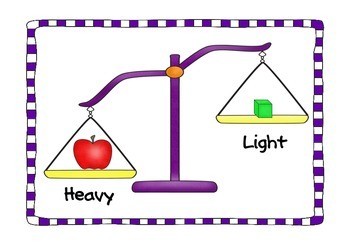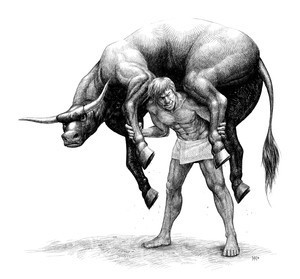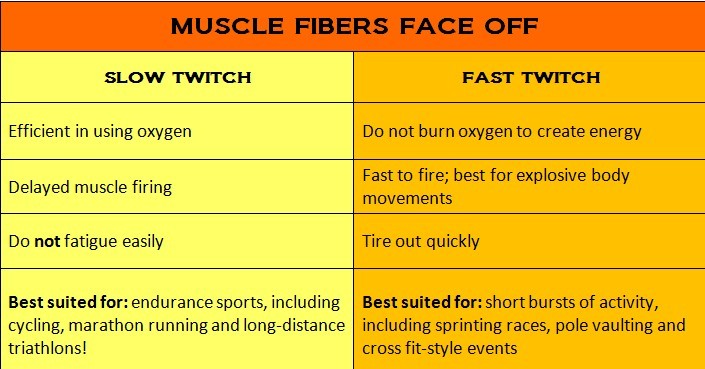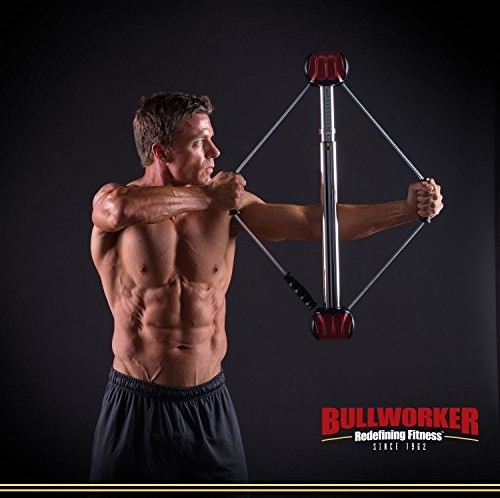THE BASICS
- What may be heavy for one may be light for another. The terms are relative.
- The same person may use differing resistance for differing movements

- It is more sensible to speak of resistance weight in terms of reps capable of being performed
- Generally, when 12 or more reps are done, it is time to increase resistance. There are exceptions.
- Capacity to perform 12 reps usually corresponds to 50 % of one rep capacity
- 6-8 reps performed generally relates to 75 % of one rep capacity, which is considered heavy resistance. My maximum bench press was 300 pounds and I would do reps with 225 – 250 pounds, usually graduating slowly to the maximum.
Both heavy resistance and light resistance are valuable. This is not an attempt to recommend one over the other; rather, an intention to discuss the qualities of both.
Heavy forms of resistance are better for building strength and power. This means using a weight that allows 4-6 reps. Heavier weights might also increase the likelihood of injury.
Lighter weights build endurance, which is vital to many sports. Also, lighter weights reduce the chances of injury. By all means, begin with lighter weights. This is the only way to develop correct form.

Working with heavy weights might be likened to preparing for a sprint or dash, while light weights may be thought of as warming up for a distance run. (This is only an analogy and not a suggestion for runners).
Muscles grow when they are compelled to do extra work. Gains are usually quite noticeable in the beginning couple of months. This is because muscles are adapting to unaccustomed workloads. Progress then levels off and more weight or different routines are needed for continued growth.
The story of Milo of Croton helps to illustrate the principle of muscle and strength growth by added resistance. Milo was a heralded Olympic wrestler in the mid 500s B.C. He was an Olympic wrestling champion 6 times. Greek mythology tells us that Milo began to carry a calf on his shoulders as a young boy. He carried the calf up a hill and continued doing so as the calf grew into a bull. Milo became stronger as the calf matured. Yet the growth of the calf was slow enough that Milo’s strength growth accommodated the added resistance.

FAST – TWITCH AND SLOW – TWITCH MUSCLE FIBERS
The human body has both fast – twitch and slow – twitch skeletal muscle fibers, generally in equal amounts. Both types activate force and motion. The differences relate precisely to our choices of weighted resistance.
Fast – twitch fibers become fatigued sooner. They have less myoglobin, the protein that binds oxygen. They are pale in color, pinkish white. They are used for short bursts of energy – heavier weight movements and sprints. They consume oxygen instantly.
Slow – twitch fibers produce energy for longer periods of time. They are bright red in color. They resist fatigue and produce moderate power for longer periods of time. Slow – twitch muscle fibers are recruited for marathon runs or a greater number of reps (at lesser resistance).

Because of genetic differences and the way we train, it is possible to become fast – twitch or slow – twitch dominant. This can become evident in our capabilities and preferences.
For training with weighted resistance, it is important to note that both fibers are activated for different purposes. Also, one type may “come to the rescue” of the other when energy wanes. Most people have an abundance of both.
ENHANCING SETS AND REPS
Advanced bodybuilders are constantly seeking ways and means to get more value from their workouts. Here are a few methods:
- Working to failure – instead of counting reps, we finish the set only when we are unable to continue because of exhaustion
- Drop sets – at the point of exhaustion, we move to a lighter weight and continue with no rest
- Negatives, or eccentric sets – this was a cornerstone of Nautilus machines and philosophy. The lowering of a weight was emphasized and considered at least as important as the raising. Apart from Nautilus, a bench press rep might be performed with the assistance of a “spotter” so that the weight to raise would be more than normal, maybe 120 % of capacity. Then the weight would be lowered without assistance. This technique was suggested at the latter part of a workout because it depleted so much energy. We can use this in our home workouts by raising a dumbbell with two hands and then lowering it with one hand.
- “Super sets” – this is the technique of pairing two sets without rest. We may do a set for biceps and then immediately continue with a set for triceps.
- High rep, light weight sets – this is the use of a lighter weight for 20- 30 reps. The resistance would be around 60% of the weight used for 10 – 12 reps. The idea is to engage the slow – twitch muscle fibers as an alternative to constant use of the fast – twitch.
- Stretching at the end with weight – an example would be to hold a dumbbell downward after completing a set of curls. This is intended to add more muscle fibers. It is important to be very careful not to overdo this, since there may be risk of tendon injury.
- Isometrics – this is strength training by static holds. The joints and muscle lengths do not change. See my article of July 9, 2019, “How Effective Is Isometric Exercise?”. Planks are isometric and are great for core training. Isometric holds may be done alone or in conjunction with isotonic movements (wherein joints and muscles are moved). Bullworker produces a line of products that are adaptable to both isometric and isotonic movements.
Some of the above techniques are not for beginners; rather, they are for experienced trainers who are seeking advanced methods to engage their muscle fibers. Please realize that moderate weights and methods are sufficiently effective for reaching most of our goals.
CHANGING RESISTANCE AT HOME
If we wish to experiment with both heavy and light weights, it is imperative to be able to use equipment that provides these alternatives. My niche (workouts at home) emphasizes equipment that does not take up a large space, yet gives us an opportunity to become as strong and fit as we wish. This is generally equipment that may be closeted or otherwise moved after use.
Here are examples. Resistance bands and dumbbells are through Amazon. As an Amazon associate, I may earn from qualifying purchases.
- Here is a set of resistance cords that includes 5 levels of resistance and all accessories
- A light set of 6 dumbbells with stand is shown here
- A heavier set of two adjustable dumbbells.
- The Bullworker product line and website
CONCLUSIONS
Please understand the differing benefits of light and heavy weights or other forms of resistance. It is important to be able to change from light to heavy and back as efficiently as we can.
We can do this with resistance cords by changing the cords that attach to the handles. 5 different levels of resistance are included in the set shown (from Amazon).
Changing weights of light dumbbells is simply a matter of selecting your choice of 3 pairs of dumbbells from the stand (from Amazon).
We can adjust the weight of heavier adjustable dumbbells by changing the plates on the two small bars, up to 52.5 pounds per dumbbell, (also from Amazon).
Bullworker products use weight provided by springs within the cylinders. There are 3 levels of resistance, easily changed. The cables may be spread, as shown above, or the handles may be compressed. (From the Bullworker company).
The traditional, time – honored method of using weights is to begin light to establish correct form. Then progress is made as we overload our muscles with weight increases. More weight is needed as performing 10 -12 reps becomes too easy. Be prepared to see very pleasing results more quickly than you may have foreseen. The drudgery of weight training is justified by a more attractive, healthier body.
Please leave any comments or questions in the “Comments” box below. Or e-mail me, richard@myworkoutathome.com.
Be well!
